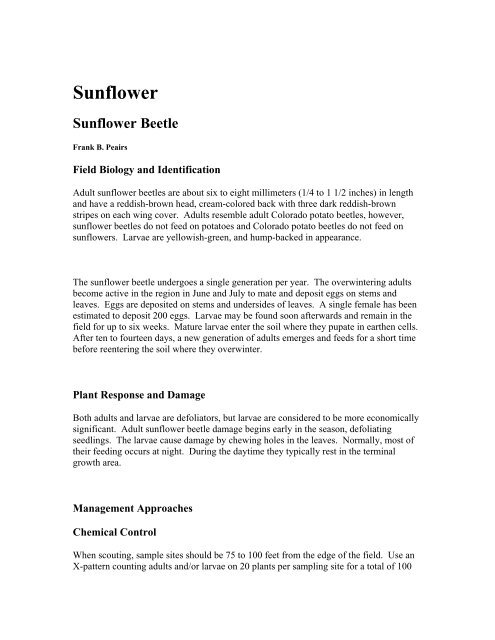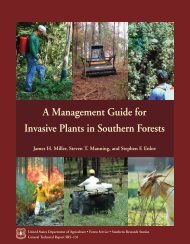Sunflower - Sunflower Beetle
Sunflower - Sunflower Beetle
Sunflower - Sunflower Beetle
You also want an ePaper? Increase the reach of your titles
YUMPU automatically turns print PDFs into web optimized ePapers that Google loves.
<strong>Sunflower</strong><strong>Sunflower</strong> <strong>Beetle</strong>Frank B. PeairsField Biology and IdentificationAdult sunflower beetles are about six to eight millimeters (1/4 to 1 1/2 inches) in lengthand have a reddish-brown head, cream-colored back with three dark reddish-brownstripes on each wing cover. Adults resemble adult Colorado potato beetles, however,sunflower beetles do not feed on potatoes and Colorado potato beetles do not feed onsunflowers. Larvae are yellowish-green, and hump-backed in appearance.The sunflower beetle undergoes a single generation per year. The overwintering adultsbecome active in the region in June and July to mate and deposit eggs on stems andleaves. Eggs are deposited on stems and undersides of leaves. A single female has beenestimated to deposit 200 eggs. Larvae may be found soon afterwards and remain in thefield for up to six weeks. Mature larvae enter the soil where they pupate in earthen cells.After ten to fourteen days, a new generation of adults emerges and feeds for a short timebefore reentering the soil where they overwinter.Plant Response and DamageBoth adults and larvae are defoliators, but larvae are considered to be more economicallysignificant. Adult sunflower beetle damage begins early in the season, defoliatingseedlings. The larvae cause damage by chewing holes in the leaves. Normally, most oftheir feeding occurs at night. During the daytime they typically rest in the terminalgrowth area.Management ApproachesChemical ControlWhen scouting, sample sites should be 75 to 100 feet from the edge of the field. Use anX-pattern counting adults and/or larvae on 20 plants per sampling site for a total of 100
plants. Determine the average number of adults and/or larvae per plant. To determinepercent defoliation of plants, examine 100 plants per sampling site for a total of 500plants.Adults attack early in the season, defoliating seedlings. One adult per plant is consideredto be economic. Later the larval stage feeds on larger plants. Fifteen larvae per plant or25 percent defoliation would justify an insecticide application. Alternatively, use thetable below to determine the potential yield loss from the observed level of defoliationEstimated % yield reduction from sunflower defoliation occurring at various growthstages (From North Dakota State University Extension Bulletin 25)Percent Defoliation10 20 30 40 50 60 70 80 90 100Growth StageExpected percent yield lossV-4 to V-5 0 1 2 2 4 4 5 9 14 21V-9 to V-11 0 2 3 4 5 5 7 11 17 24R-1 2 4 6 6 7 9 16 24 34 47R-3 2 8 15 19 24 32 44 59 78 99R-5 1 3 7 10 16 25 37 49 67 90R-7 0 1 3 7 10 13 16 18 20 22R-8 0 1 2 3 5 7 8 9 10 11ai/acre/crop. Do not graze or feed treated forageProduct list for <strong>Sunflower</strong> <strong>Beetle</strong>PesticideProduct/Acre (Fl oz. or oz. Preharvest Interval, remarksproduct)Asana XL R,1 2.9 - 5.8 28 days. Do not feed forage or fodder tolivestockExtremely Hazardous to Bees!Baythroid XL R,1 0.8 – 1.6 30 days. Extremely Hazardous to Bees!carbaryl 1,2 See labels 60 days. 30 days to graze or forage. ExtremelyHazardous to Bees!chlorpyrifos 4E R1,2 16 - 24 42 days. Do not graze. Up to 2 lb preplant. Up ttotal AI/yr. Extremely Hazardous to Bees!Delta Gold R,1 1.0 – 1.5 21 days to harvest. Do not apply more than 0.04livestock. Extremely Hazardous to Bees!Furadan 4F R4-8 (foliar)28 days. Apply only before bloom. ExtremelyHazardous to Bees!2.5-5.0 oz./1000 row ft
R Restricted use pesticide. 1 Labeled for chemigation. 2 Generic active ingredient, may be additional formulatiThe information herein is supplied with the understanding that no discrimination is intended and that listing of commercial products, necessary to this guide, implieendorsement by the authors or the Extension Services of Nebraska, Colorado, Wyoming or Montana. Criticism of products or equipment not listed is neither implieintended. Due to constantly changing labels, laws and regulations, the Extension Services can assume no liability for the suggested use of chemicals contained hereinmust be applied legally complying with all label directions and precautions on the pesticide container and any supplemental labeling and rules of state and federal pregulatory agencies. State rules and regulations and special pesticide use allowances may vary from state to state: contact your State Department of Agriculture forProduct list for <strong>Sunflower</strong> <strong>Beetle</strong>PesticideProduct/Acre (Fl oz. or oz. Preharvest Interval, remarksproduct)(planting time)lambda cyhalothrin R1,2 1.92 – 3.20 45 days. Do not exceed 0.12 lb total AI/yr. ExtrHazardous to Bees!Proaxis R,1 1.92 – 3.20 45 days. Do not exceed 0.06 lb total AI/yr. ExtrHazardous to Bees!regulations and allowances applicable in your state and locality.Categories: <strong>Sunflower</strong>, Insects, <strong>Sunflower</strong> beetleDate: 5/17/2007
















